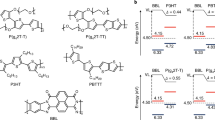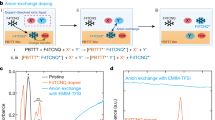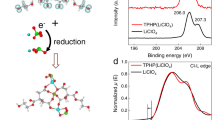Abstract
Solution-based electrical doping protocols may allow more versatility in the design of organic electronic devices; yet, controlling the diffusion of dopants in organic semiconductors and their stability has proven challenging. Here we present a solution-based approach for electrical p-doping of films of donor conjugated organic semiconductors and their blends with acceptors over a limited depth with a decay constant of 10–20 nm by post-process immersion into a polyoxometalate solution (phosphomolybdic acid, PMA) in nitromethane. PMA-doped films show increased electrical conductivity and work function, reduced solubility in the processing solvent, and improved photo-oxidative stability in air. This approach is applicable to a variety of organic semiconductors used in photovoltaics and field-effect transistors. PMA doping over a limited depth of bulk heterojunction polymeric films, in which amine-containing polymers were mixed in the solution used for film formation, enables single-layer organic photovoltaic devices, processed at room temperature, with power conversion efficiencies up to 5.9 ± 0.2% and stable performance on shelf-lifetime studies at 60 °C for at least 280 h.
This is a preview of subscription content, access via your institution
Access options
Subscribe to this journal
Receive 12 print issues and online access
$259.00 per year
only $21.58 per issue
Buy this article
- Purchase on Springer Link
- Instant access to full article PDF
Prices may be subject to local taxes which are calculated during checkout





Similar content being viewed by others
Change history
10 January 2017
In the original version published, the S(2s) peak in Fig. 2a was not clearly labelled. This has now been corrected.
References
Maennig, B. et al. Organic p–i–n solar cells. Appl. Phys. A 79, 1–14 (2004).
Liu, C., Xu, Y. & Noh, Y.-Y. Contact engineering in organic field-effect transistors. Mater. Today 18, 79–96 (March 2015).
Lüssem, B., Riede, M. & Leo, K. Doping of organic semiconductors. Phys. Status Solidi A 210, 9–43 (2013).
Heliatek sets new Organic Photovoltaic world record efficiency of 13.2% (8 February 2016); http://www.heliatek.com/en/press/press-releases/details/heliatek-sets-new-organic-photovoltaic-world-record-efficiency-of-13-2
Walzer, K., Maennig, B., Pfeiffer, M. & Leo, K. Highly efficient organic devices based on electrically doped transport layers. Chem. Rev. 107, 1233–1271 (2007).
Meerheim, R., Furno, M., Hofmann, S., Lüssem, B. & Leo, K. Quantification of energy loss mechanisms in organic light-emitting diodes. Appl. Phys. Lett. 97, 253305 (2010).
Salzmann, I., Heimel, G., Oehzelt, M., Winkler, S. & Koch, N. Molecular electrical doping of organic semiconductors: fundamental mechanisms and emerging dopant design rules. Acc. Chem. Res. 49, 370–378 (2016).
Yoo, S.-J. & Kim, J.-J. Charge transport in electrically doped amorphous organic semiconductors. Macromol. Rapid Commun. 36, 984–1000 (2015).
Espinosa, N., Hosel, M., Angmo, D. & Krebs, F. C. Solar cells with one-day energy payback for the factories of the future. Energy Environ. Sci. 5, 5117–5132 (2012).
Loiudice, A., Rizzo, A., Biasiucci, M. & Gigli, G. Bulk heterojunction versus diffused bilayer: the role of device geometry in solution p-doped polymer-based solar cells. J. Phys. Chem. Lett. 3, 1908–1915 (2012).
Mandoc, M. M., Kooistra, F. B., Hummelen, J. C., de Boer, B. & Blom, P. W. M. Effect of traps on the performance of bulk heterojunction organic solar cells. Appl. Phys. Lett. 91, 263505 (2007).
Mi, B. X., Gao, Z. Q., Cheah, K. W. & Chen, C. H. Organic light-emitting diodes using 3,6-difluoro-2,5,7,7,8,8-hexacyanoquinodimethane as p-type dopant. Appl. Phys. Lett. 94, 073507 (2009).
Huang, J., Blochwitz-Nimoth, J., Pfeiffer, M. & Leo, K. Influence of the thickness and doping of the emission layer on the performance of organic light-emitting diodes with PiN structure. J. Appl. Phys. 93, 838–844 (2003).
Mor, G. K. et al. Contact doping with sub-monolayers of strong polyelectrolytes for organic photovoltaics. Adv. Energy Mater. 4, 1–6 (2014).
Li, J. et al. Measurement of small molecular dopant F4TCNQ and C60F36 diffusion in organic bilayer architectures. ACS Appl. Mater. Interfaces 7, 28420–28428 (2015).
Dai, A. et al. Investigation of p-dopant diffusion in polymer films and bulk heterojunctions: stable spatially-confined doping for all-solution processed solar cells. Org. Electron. 23, 151–157 (2015).
Dai, A. et al. Enhanced charge-carrier injection and collection via lamination of doped polymer layers p-doped with a solution-processible molybdenum complex. Adv. Funct. Mater. 24, 2197–2204 (2014).
Aizawa, N. et al. Simultaneous cross-linking and p-doping of a polymeric semiconductor film by immersion into a phosphomolybdic acid solution for use in organic solar cells. Chem. Commun. 52, 3825–3827 (2016).
Keggin, J. F. Structure of the crystals of 12-phosphotungstic acid. Nature 132, 351 (1933).
Aizawa, N. et al. Instant low-temperature cross-linking of poly(N-vinylcarbazole) for solution-processed multilayer blue phosphorescent organic light-emitting devices. Adv. Mater. 26, 7543–7546 (2014).
Zhu, Y. W. et al. A cost-effective commercial soluble oxide cluster for highly efficient and stable organic solar cells. J. Mater. Chem. A 2, 1436–1442 (2014).
Jia, X. et al. Highly efficient low-bandgap polymer solar cells with solution-processed and annealing-free phosphomolybdic acid as hole-transport layers. ACS Appl. Mater. Interfaces 7, 5367–5372 (2015).
Alaaeddine, M. et al. Enhancement of photovoltaic efficiency by insertion of a polyoxometalate layer at the anode of an organic solar cell. Inorg. Chem. Front. 1, 682–688 (2014).
Vasilopoulou, M. et al. Annealing-free highly crystalline solution-processed molecular metal oxides for efficient single-junction and tandem polymer solar cells. Energy Environ. Sci. 8, 2448–2463 (2015).
Chen, H.-Y. et al. Polymer solar cells with enhanced open-circuit voltage and efficiency. Nat. Photon. 3, 649–653 (2009).
Liang, Y. Y. et al. For the bright future-bulk heterojunction polymer solar cells with power conversion efficiency of 7.4%. Adv. Mater. 22, E135–E138 (2010).
Wang, M. et al. High open circuit voltage in regioregular narrow band gap polymer solar cells. J. Am. Chem. Soc. 136, 12576–12579 (2014).
Ma, W. et al. Influence of processing parameters and molecular weight on the morphology and properties of high-performance PffBT4T-2OD:PC71BM organic solar cells. Adv. Energy Mater. 5, 1501400 (2015).
Sirringhaus, H. 25th anniversary article: organic field-effect transistors: the path beyond amorphous silicon. Adv. Mater. 26, 1319–1335 (2014).
Deckman, I., Moshonov, M., Obuchovsky, S., Brener, R. & Frey, G. L. Spontaneous interlayer formation in OPVs by additive migration due to additive-metal interactions. J. Mater. Chem. A 2, 16746–16754 (2014).
Shamieh, B., Obuchovsky, S. & Frey, G. L. Spontaneous generation of interlayers in OPVs with silver cathodes: enhancing Voc and lifetime. J. Mater. Chem. C 4, 1821–1828 (2016).
Kang, H. et al. Simplified tandem polymer solar cells with an ideal self-organized recombination layer. Adv. Mater. 27, 1408–1413 (2015).
Ma, D. et al. Self-organization of amine-based cathode interfacial materials in inverted polymer solar cells. ACS Nano 8, 1601–1608 (2014).
Brown, P. J. et al. Effect of interchain interactions on the absorption and emission of poly(3-hexylthiophene). Phys. Rev. B 67, 064203 (2003).
Brown, P. J., Sirringhaus, H., Harrison, M., Shkunov, M. & Friend, R. H. Optical spectroscopy of field-induced charge in self-organized high mobility poly(3-hexylthiophene). Phys. Rev. B 63, 125204 (2001).
Burgot, J.-L. Ionic Equilibria in Analytical Chemistry Vol. 772 (Springer, 2012).
Mendez, H. et al. Charge-transfer crystallites as molecular electrical dopants. Nat. Commun. 6, 8560 (2015).
Pingel, P. & Neher, D. Comprehensive picture of p-type doping of P3HT with the molecular acceptor F4TCNQ. Phys. Rev. B 87, 115209 (2013).
Shallcross, R. C. et al. Quantifying the extent of contact doping at the interface between high work function electrical contacts and poly(3-hexylthiophene) (P3HT). J. Phys. Chem. Lett. 6, 1303–1309 (2015).
Kyaw, A. K. K. et al. An inverted organic solar cell employing a sol-gel derived ZnO electron selective layer and thermal evaporated MoO3 hole selective layer. Appl. Phys. Lett. 93, 221107 (2008).
Tan, Z. A. et al. Efficient and stable polymer solar cells with solution-processed molybdenum oxide interfacial layer. J. Mater. Chem. A 1, 657–664 (2013).
Girotto, C., Voroshazi, E., Cheyns, D., Heremans, P. & Rand, B. P. Solution-processed MoO3 thin films as a hole-injection layer for organic solar cells. ACS Appl. Mater. Interfaces 3, 3244–3247 (2011).
Murase, S. & Yang, Y. Solution processed MoO3 interfacial layer for organic photovoltaics prepared by a facile synthesis method. Adv. Mater. 24, 2459–2462 (2012).
Wang, G. et al. In situ growth of columnar MoO3 buffer layer for organic photovoltaic applications. Org. Electron. 15, 29–34 (2014).
Meyer, J. et al. Transition metal oxides for organic electronics: energetics, device physics and applications. Adv. Mater. 24, 5408–5427 (2012).
Lide, D. R. CRC Handbook of Chemistry and Physics (CRC Press, 2015).
Dweydari, A. W. & Mee, C. H. B. Work function measurements on (100) and (110) surfaces of silver. Phys. Status Solidi A 27, 223–230 (1975).
Ran, N. A. et al. Harvesting the full potential of photons with organic solar cells. Adv. Mater. 28, 1482–1488 (2016).
Zhou, Y. H. et al. A universal method to produce low-work function electrodes for organic electronics. Science 336, 327–332 (2012).
Takahashi, T., Tokailin, H. & Sagawa, T. Angle-resolved ultraviolet photoelectron-spectroscopy of the unoccupied band-structure of graphite. Phys. Rev. B 32, 8317–8324 (1985).
Acknowledgements
This work was funded in part by the Department of the Navy, Office of Naval Research Award No. N00014-14-1-0580 and N00014-16-1-2520, through the MURI Center CAOP, Office of Naval Research Award N00014-04-1-0313 and by the Department of Energy through the Bay Area Photovoltaic Consortium under Award Number DE-EE0004946. The authors would also like to thank J. Anthony and S. Barlow for helpful discussions. B.K. acknowledges a Visiting Professorship from the University of Cologne, Germany.
Author information
Authors and Affiliations
Contributions
V.A.K., C.F.-H., N.A., S.R.M., W.-F.C., F.A.L. and B.K. conceived and developed the ideas. V.A.K. and F.A.L. designed the experiments and performed device fabrication, electrical characterization. A.P., C.F.-H. and S.G. performed shelf lifetime and thermal stress experiments. C.F.-H. and W.-F.C. performed photo-oxidation and spectroscopic ellipsometry experiments. C.F.-H. modelled spectroscopic ellipsometry data. S.C. and W.-F.C. performed XPS measurements. M.W., G.C.B. and T.-Q.N. synthesized the donor polymer PIPCP used in this study. C.F.-H., S.R.M. and B.K. coordinated and directed the study. All authors contributed to the manuscript preparation.
Corresponding author
Ethics declarations
Competing interests
The authors declare no competing financial interests.
Supplementary information
Supplementary Information
Supplementary Information (PDF 4433 kb)
Rights and permissions
About this article
Cite this article
Kolesov, V., Fuentes-Hernandez, C., Chou, WF. et al. Solution-based electrical doping of semiconducting polymer films over a limited depth. Nature Mater 16, 474–480 (2017). https://doi.org/10.1038/nmat4818
Received:
Accepted:
Published:
Issue Date:
DOI: https://doi.org/10.1038/nmat4818
This article is cited by
-
In situ-formed tetrahedrally coordinated double-helical metal complexes for improved coordination-activated n-doping
Nature Communications (2022)
-
Approaching disorder-tolerant semiconducting polymers
Nature Communications (2021)
-
Quantifying charge carrier localization in chemically doped semiconducting polymers
Nature Materials (2021)
-
Adduct-based p-doping of organic semiconductors
Nature Materials (2021)
-
Machine learning powered ellipsometry
Light: Science & Applications (2021)



